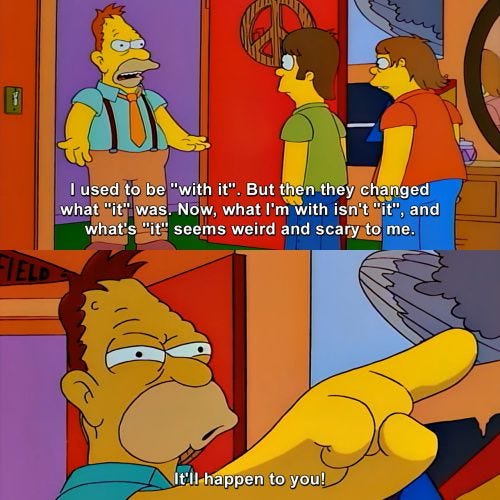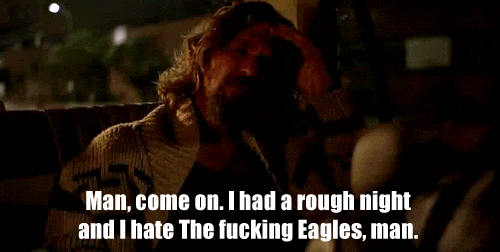No. 25 - Out with the new 🌱 and in with the old 🌲(music) edition
Is old music actually better than the music of today?
Shots were recently fired in the ongoing “Music was better back in [insert decade when commenters were b/w the ages of 15-25]” wars. Old music now makes up 70 percent of the music market, and the new music portion is shrinking.
Source: MRC Data via the Atlantic, which is where I snagged this.
Have the olds won? Have hard streaming numbers finally put this fight to bed? Was “their” music really better than “ours”?
Hardly.
New music — which the industry defines as anything released in the past 18 months — actually ceded its market share to old music back in 2015, though its proportion was still growing, albeit more slowly.
It’s very easy to point out what’s bad in the current era. It’s much harder to remember the pap that once clogged the charts in a past one. When people say that music was better in the 90s, they’ll point to Nirvana, Biggie or Bjork while conveniently ignoring all the treacly ballads, dour post-grunge and D-list teen pop. History has already sorted past decades into winners and losers in a way that simply can’t occur in the present. The 1960s are held up as the penultimate decade of the rock era, yet even in the closing days of 1969 few would have named the Velvet Underground as one of the era’s most important artists.
But the music biz has always been a winner-take-all proposition where the top tier of artists reaps a disproportionate share of the profits and all the intangible elements that come with it. That structure favours legacy acts whose reputations — rather than musical or cultural relevance — ensures that they’re the first names casual fans look to when trying to decide what records to buy, music to stream, or concerts to attend. You can see this play out as some of the rock era’s biggest legacy acts sell off their publishing rights to firms like Hipgnosis, Primary Wave and UMG, or use their cultural capital to pick fights with streaming services.
Thanks in large part to technology shifts that have drastically democratized music creation and distribution over the last decade, 60,000 new songs get uploaded to streaming services every day. That’s a lot of noise for your average listener to sift through. Faced with an overabundance of choice, I'm sure that many people simply fall back into old patterns and the algorithms that power these services reinforce this behaviour by spoon-feeding them more of the same. (That’s not a criticism of listeners. I've written about personally struggling to break out of this loop as well.)
So there’s still A LOT of new music being made and, if you read the music press or this newsletter, a lot of it is very good. It’s just that, according to music analytics firm MRC Data, not that many people are listening to it.
There are many, many reasons for that, none of it which is related to quality. One could be a growing musical generation gap. The same technology shifts I talked about above have also blown up the idea that an artist needs to fall in line with some sense of musical history (I heard this idea in a recent episode of the New York Times Popcast, but I think it applies here). There’s been a literal break with the musical past. The fact that artists can circumvent normal channels — radio, labels, etc. — to find a like-minded audience means that they’re no longer reliant on traditional gatekeepers (like me!) who tend to prefer that things fit some musical lineage. So when they’re presented by artists like 100 Gecs, Glaive, dltzk, Bladee or whatever the new weird thing is, ahistorical musicians whose appeal is based around the idea that they don’t fit it into an understood narrative, many tend to balk. So basically, when given a choice with the Eagles or a new digicore artist whose music explicitly references something from the Final Fantasy video game franchise, most people are choosing the Eagles.
So what does this all mean?
To listeners, probably nothing. You’re average music fan will likely continue to follow their usual listening habits, reinforced by the algorithms that power the various streaming services. For artists, however, especially young ones, it means that the top acts’ success will continue to be perpetuated. The music industry, like any capitalistic enterprise, follows the money, and for decades that meant whatever was new. Now you can already see the flip playing out in how labels are allocating their promotion budgets.
The picture above shows off just a few of the posters advertising “catalog” releases from labels that I’ve seen around downtown Toronto over the past few months. For those keeping score, Stankonia, the newest album advertised, is 22 years old. Leonard Cohen died six years ago at the age of 82 (the poster is advertising the 50th anniversary of Songs of Love and Hate) and I doubt Loverboy’s been the recipient of much in the way of promo money since the early 90s.
I have nothing against any of these albums (though I can’t say I have many positive things to say about Loverboy either). But the money that goes into ad campaigns like these used to be reserved for new artists or new releases from currently popular ones. Now that money’s being funneled into artists whose legacies have long been cemented.
Added to the pittance that streaming services pay to most artists and trying to make a living, let alone becoming a star, starts to feel like an even more insurmountable mountain than it was 20 years ago. If the record industry is worried about the shrinking footprint of the next generation — and it kind of seems like they should be — they’ve only got themselves to blame.
Kool Kids Self-promotion Club
I was also lucky enough to interview Softcult about their new EP Year of the Snake for the latest issue of Exclaim! The band rose from the ashes of Courage My Love, the pop-punk trio Mercedes and Phoenix Arn-Horn founded as teenagers. Softcult deftly mixes riot grrrl politics, dream pop and shoegaze soundscapes all wrapped in a nice mall goth aesthetic. Says Mercedes of the project: “We agreed that no matter what happens, even if this project just becomes a hobby, even if music’s not our career, we're just always gonna write music that we love and that fulfills us.”
Kool Kids Music Recommendation Club
Lily Konigsberg has been on something of a small-scale role over the past 14 months. At the beginning of last year, she dropped Palberta500 as 1/3 of New York indie trio Palberta. She released her latest solo project Lily We Need to Talk Now in the fall. What starts out as a very good 90s indie rock homage opens up into a more DIY pan-pop offering, albeit played with guitar, bass and drums with a decidedly DIY aesthetic.
To further prove my point that Lily Konigsberg has been low-key killing it lately, I thought I’d drop a second offering from the New York-based artist. My Idea is a collab with Water From Your Eyes’ Nate Ramos. The pair released an EP last summer and now their debut Cry Mfer is out April 2 on Hardly Art. Its title track seems to split the difference between the two artists’ respective sounds, playing to each other’s strengths, with Lily singing a beautiful melody over bubbling production.
Now, who are Water From Your Eyes you might be asking? Nate Ramos and Rachel Brown have been making music under the name for some time now, but last year’s Structure broke the group out to a wider audience. I honestly don’t know how to describe the project: it’s electronic, modern classical, minimalist, pop and indie rock all rolled into one deeply compelling title. Honestly, they remind me of the first time I heard Dirty Projectors in the sense that it was both immediately recognizable, yet totally foreign at the same time. “When You’re Around” on the other hand sounds like a lovely, sad, lost Harry Nilsson or Brian Wilson track from the 70s.
Okay, I have no through-line to Meet Me @ The Altar so you’ll just have to trust me that they’re a great band. The trio met online and self-released a full-length and a number of EPs before signing with pop-punk powerhouse Fueled By Ramen for last year’s great Model Citizen EP. The band are one of the very few modern groups playing the much-ballyhooed When We Were Young festival, aka MySpace Prom in Vegas this spring (if anyone wants to send me out west to cover this nostalgia party, HMU), which along with their label affiliation should give you a pretty good idea of their sound (Paramore would be the obv comparison but they remind me a lot of San Francisco band Heartsounds). I like that their clip for “Now or Never” sort of calls back to that time a bunch of kids threw a hardcore show at a Dennys.
Tallies were just starting to break out when the pandemic hit, but thankfully the Toronto dream-pop trio survived the break. They’ve re-emerged with not one but two new tracks that will form part of an upcoming mini-EP with last year’s “No Dreams of Fayres.” “Wound Up Tight” is my favourite of the two; it toughens up Tallies’ sound and the part in the chorus where singer Sarah Cogan’s voice spins out into outer space reminds me a bit of the part near the end of “Ray of Light” where Madonna similarly loses the plot in a wail of ecstasy.
Ian Gormely is a freelance music journalist based in Toronto.
Hit up koolkidsmusicclub@gmail.com for questions, criticisms and submissions.





